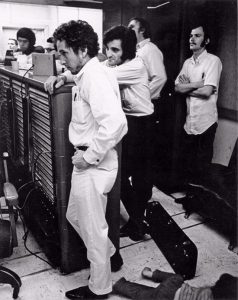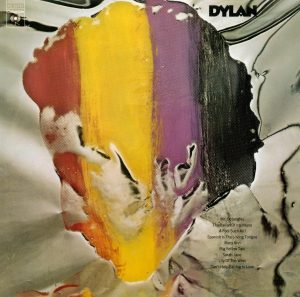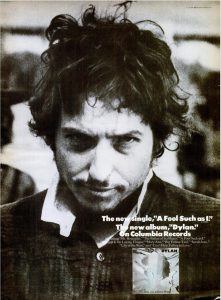by Patrick Roefflaer
This is the 30th article in our unique series looking at the artwork on Bob Dylan’s albums. A full list of the articles in the series is published here.
The album: Dylan
- Released: November 16, 1973
- Illustration: Richard Kenerson
- Art-director: John Berg
The exact date Bob Dylan signed a contract with Asylum is nowhere to be found. Some suggest there may be no contract at all. According to Rolling Stone, it was a gentlemen’s agreement, sealed with a handshake.
Therefore it is not clear what the arrangements are for the Dylan album, in the switch from the singer to another record company, after 12 years with Columbia Records.
According to one story, the album is seen as an act of revenge by his old firm, to ridicule the renegade artist by releasing substandard material. Others think it is the last straw, after which Dylan closes the door and makes the switch. Away from the firm that sees him as a has-been and would rather lose him than keep him.
 Anyway, for the first time ever, Bob Dylan has no say in the cover of one of his records.
Anyway, for the first time ever, Bob Dylan has no say in the cover of one of his records.
As asking Dylan to pose for a cover photo is not an option, the graphics department has to work with existing material. A photo by Al Clayton is chosen. Curiously, it was previously printed on the inner sleeve of Self Portrait. The photo, taken on May 3, 1969, shows Dylan, along with some musicians, listening to a playback of a recording, while his son Jesse is playing on the floor.
Richard Kenerson uses an enlarged view of Dylan’s head from this photo as the basis for a screen print. The portrait in profile is placed in front of a metallic, silver-colored background and then enhanced with a red, yellow, purple and black stripe. It remains a guess as to the intention.
Dylan’s head from this photo as the basis for a screen print. The portrait in profile is placed in front of a metallic, silver-colored background and then enhanced with a red, yellow, purple and black stripe. It remains a guess as to the intention.
There is not much more information on the cover. And a little piece of information provided, raises further questions: “Back cover photograph and album design by John Berg.”
Remarkable, because the image of the front is simply reproduced once more, albeit in a more sober version without the colored stripes. Perhaps Berg provided the photo placed over it: something that most resembles boulders in a river bed.
A few weeks after the album was released, there is a single: “A Fool Such As I”.
Apparently, a more recent photo of the singer has been found to promote it. Its’ a black-and-white photo, taken during the filming of Pat Garrett and Billy the Kid.
Dylan is shown squinting into the lens, with a look that is somewhere between amused and annoyed. Wouldn’t this have been a better image for the cover?
Side 1
2: Can’t help falling in love
3: Sarah Jane
4: The Ballad of Ira Hayes
Side 2
1: Mr Bo Jangles
2: Mary Anne
3: Big Yellow Taxi
4: A fool sucyh as I
5: Spanish is the Loving Tongue




I’ve always been amused by the fact that the cover of Blood on the Tracks is broadly similar … the Columbia art department continued to lack inspiration in this period, blowing up bits of other pictures and colouring them!
Dylan had no say over the cover/artwork of “GREATEST HITS” in 1967.
The cover of “Dylan” (a/k/a “Columbia’s Revenge”) should have been a dead giveaway as to the dreadful music contained within its grooves. Has there ever been any documentation of the track selection process for this album? Did they literally just grab the first reel of tape they saw in the vault? Given the amount of quality unreleased material available from the 1969-70 era, as evidenced by 2013’s “Another Self Portrait” release, at least half of the choices on “Dylan” are downright bizarre!
@ David Lewis: there’s another story coming for you soon: Blood on the Tracks, and that art work was made.
twm: you’re right. Greatest Hits was another album made by Columbia without input or permission from Bob Dylan. That story is in the archives: https://bob-dylan.org.uk/archives/10887
From Nashville Skyline forward, many Dylan releases were head scratchers…at least for the culture of the times they were released in, directions Dylan chose or, in this case, a direction Columbia chose.
Listening today to Dylan’s path from Nashville Skyline up to the Dylan/Band live release Down In The Flood, one can appreciate far better the choices, the searching, the sounds that Mr. Dylan played with and explored. Along with the plethora of Bootleg Series releases that chronicled this same time period, it is evident that Dylan was exploring a wide range of American performers and their signature sounds. Here was the troubadour taking a slice of America, saluting it, honoring its place in the canon of American music and making it his own.
I may be the only American left who truly appreciated and respected the ‘Dylan’ album when it first came out…and I like it still today. Well, the version he does of ‘Spanish is the Loving Tongue’ on ‘Dylan’ is an experimental stretch and makes me glad I had the 45 single of the same song, just vocal and piano.